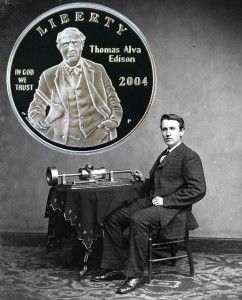Today, the Thomas Alva Edison Commemorative Silver Dollar Coin remembers the activities of the young inventor back in 1877.
Like many inventors, Edison took advantage of serendipity.
In his Menlo Park laboratory, he worked on improving the telephone when the stylus attached to the vibrating membrane pricked his finger and drew blood.
He wondered, if the vibration caused by the voice was sufficient to prick the skin, could that same vibration be recreated by applying the stylus on a flexible surface.
He suggested, “the same outlines might mechanically reproduce the vibrations which had caused them, by reacting on a plate capable of vibrating in the same say as that which he had already used for the reproduction of the Morse signals.”
As with his light bulb invention, Edison was not the first to invent the phonograph, however he was the first to invent a marketable version.
In addition to being an inventor, Edison continually thought of ways his inventions could work.
For the phonograph, Edison identified the initial purposes:
“First. — For dictating it will take the place of short-hand reporters, as thus : A man who has many letters to write will talk them to the phonograph, and send the sheets directly to his correspondents, who will lay them on the phonograph and hear what they have to say. Such letters as go to people who have no phonographs will be copied from the machine by the office boy.
“Second. — For reading. A first-class elocutionist will read one of Dickens’ novels into the phonograph. It can all be printed on a sheet ten inches square, and these can be multi plied by the million copies by a cheap process of electrotyping. These sheets will be sold for, say, twenty-five cents. A man is tired, and his wife’s eyes are failing, and so they sit around and hear the phonograph read from this sheet the whole novel with all the expression of a first-class reader. See? A company for printing these is already organized in New York.
“Third. — It will sing in the very voice of Patti and Kellogg, so that every family can have an opera any evening.
“Fourth. — It may be used as a musical composer. When singing some favorite airs backward it hits some lovely airs, and I believe a musician could get one popular melody every day by experimenting in that way.
“Fifth. — It may be used to read to inmates of blind asylums, or to the ignorant, who have never learned to read.
“Sixth. — It may be used to teach languages, and I have already sold the right to use it to teach children the alphabet. Suppose Stanley had had one and thus obtained for the world all the dialects of Central Africa!
“Seventh. — It will be used to make toys talk. A company has already organized to make speaking dolls. They will speak in a little girl’s voice and will never lose the gift any more than a little girl.
“Eighth. — It will be used by actors to learn the right readings of passages.
“In fact, its utility will be endless.”
Wouldn’t it be interesting to see and hear Edison’s reaction to how his inventions have evolved over the years?
The Thomas Alva Edison Commemorative Silver Dollar Coin shows against a picture of a young Edison with his early phonograph.
